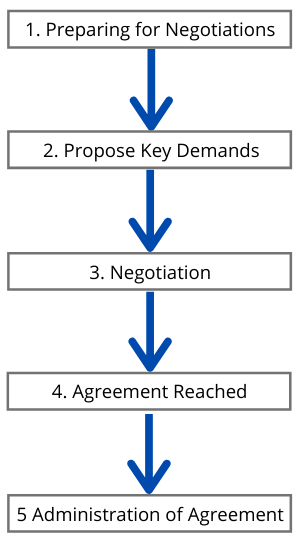Collective Bargaining: Definition, Types & Examples

What is Collective Bargaining?
Collective bargaining is the process by which a group of employees negotiates with their employer on matters related to their pay, working conditions, benefits, and other compensation-related factors.
Typically, this negotiation is conducted through a trade union that represents its members, with union representatives negotiating on their behalf. The negotiation may occur at the level of an individual business or may involve an entire industry, such as when a retail trade union like USDAW negotiates with major retailers like Walmart, Target, and Costco to establish industry-wide agreements regarding minimum wages, benefits, and working conditions for retail workers.
Key Points
- Collective bargaining is where a group of employees get together to negotiate better terms with their employer.
- A collective bargaining agreement usually covers items such as pay, benefits, working conditions, and pensions.
- Collective bargaining typically involves a union or labor organization representing a group of workers, and the employer or a representative of the employer.
What Happens in Collective Bargaining

Collective bargaining is often handled by trade unions, which employees pay a monthly fee to be a member of. These unions have a negotiating team that works on behalf of the employees.
The bargaining process involves several steps, starting with preparing for negotiations and proposing key demands, followed by actual negotiation. Once an agreement is reached, there is typically a period of administering the agreement to ensure that it is implemented properly.
1. Preparing for Negotiations
This may cover a number of areas that its members are most concerned with. It may include a survey of members or several focus groups.
Simply put, the trade union and negotiators look to find out the key points by which they are to negotiate on.
For instance, the lack of local canteen may be an issue, or alternatively, workers want to get paid extra to work Sundays. Whatever the key issues, the first stage would be to compile these ready for the negotiation.
2. Propose Key Demands
Once the union members’ key issues have been identified, they are compiled into an official document known as the “key demands.” These demands may include “red lines” which the negotiation must start with, such as wages or key benefits to the employees. If these demands are not met, negotiations may fall apart.

Additionally, the key demands may include conditions under which the union would ask its members to go on strike if certain criteria are not agreed upon or met. For example, the union may demand a set minimum wage or a higher wage for overtime.
3. Negotiation
The negotiation process may involve sit-down meetings, email exchanges, or phone calls where details of the deal are discussed. During this stage, both sides may request the inclusion or exclusion of certain aspects of the deal.

In addition, both parties may take time to gather information and assess the feasibility of specific demands or proposals. For instance, if the employees demand a 10% increase in their salary, the employer will have to evaluate whether it is financially feasible.
The negotiation process may continue in a circular fashion until a mutually agreeable deal is reached, or negotiations may break down entirely.
4. Agreement Reached

An agreement is typically reached in principle, and it is at this stage where the more intricate details are hammered out. This may include legal wording and binding agreements that both parties are liable for. Once all the details have been worked out, legal documents are then signed to formalize the agreement.
In short, this stage is where the agreement is finalized and all the necessary details are arranged.
5. Administration of Agreement
After an agreement is reached, the union will continue to monitor the implementation of the agreement and hold the employer accountable. This involves ensuring that the terms of the agreement are being met, such as employees receiving the agreed-upon minimum salary or the construction of the requested canteen being completed on time and to a satisfactory standard.
Additionally, some agreements may have a predetermined expiration date, at which point another round of negotiations will take place. This highlights how collective bargaining is an ongoing process and not just a one-time event.
Types of Collective Bargaining
When discussing collective bargaining, it is important to distinguish between the process and the outcome, which is known as a collective agreement.
There are different types of collective agreements that can result from bargaining, including single union deals, procedural agreements, substantive agreements, and partnership agreements. These types refer to the characteristics of the agreement itself rather than the bargaining process.
1. Distributive Bargaining
Distributive bargaining involves negotiation by which one party gains at the expense of another, often relating to the redistribution of income through higher wages, bonuses, or other financial benefits.
Trade unions need to have market power to win negotiations, as employers want to pay as little as possible. The larger the percentage of employees represented by a union, the more power the union has.
For instance, if a union represents 100% of an employer’s workforce, it has significant power. If the union calls for a strike, it can cause significant disruption to the employer, resulting in distributive bargaining favoring the union.
2. Integrative Bargaining
Integrative bargaining is a process where both sides aim to benefit, creating a ‘win-win’ situation. Both parties bring together a list of demands and an agreement is reached that benefits both sides.
This process involves both parties considering the others’ point of view, needs, wants, fears, and concerns. As a result, both parties gain or lose by the same amount. For example, a union may advocate for greater staff training, which may cost the business more initially but result in greater productivity in the long run.
Integrative bargaining can also involve both sides losing something in order to gain something else. For instance, the union may be willing to give up yearly bonuses in exchange for a higher annual salary, or accept a pay freeze in order to achieve better working conditions. In this way, workers may lose out on lower real wages, while the employer invests in better conditions.
3. Productivity Bargaining
Productivity bargaining involves both parties negotiating around productivity and pay. So unions may suggest that higher salaries would boost productivity. However, this is unknown to the business. So target-orientated bonuses may be suggested, or new ways of improving the process.
Unions may suggest new ways of organising the worker force than may increase productivity and therefore create value to the firm. In turn, employers would look to increase employees wages as a result.
Simply put, productivity bargaining is where the two parties look to agree to changes that would boost productivity in return for higher wages or other benefits.
4. Composite Bargaining
Composite bargaining refers to a negotiation that focuses on a number of elements that are not related to pay. They are generally related to employee welfare and job security. For instance, it covers factors such as working conditions, policies, recruitment, and disciplinary processes.
The aim is to ensure a mutually beneficial long-term relationship between the employer and employee. It does this by highlighting issues that employees may have, which may impact their long-term future at the company.
Businesses want to retain talent, particularly if they spend time and money training them up. Factors such as workload and working conditions can impact on this long-term relationship. So it is in the best interest of both parties to ensure that the employees are happy.
5. Concessionary Bargaining
Concessionary bargaining is based on unions giving back previous benefits to the employer. For instance, trade unions may agree to lower wages in return for job security.
This may come during an economic decline whereby job security is more important to the unions than higher wages. Overall, this may actually benefit the company as they won’t have to pay for so many redundancies and can keep workers on.
The main aim of concessionary bargaining is to strengthen the business in order to ensure its survival alongside its employees. So unions give back previous benefits in order to secure the businesses’ long-term future and therefore its members.
Collective Bargaining Examples
NFL Collective Bargaining Agreement
In 1968, the National Football League Players Association (NFLPA) and National Football League (NFL) came to its first collective bargaining agreement. The NFLPA was the first recognised players union and in 1968 they went on strike over pay and pensions.

After eleven days of strikes, an agreement was reached which increased salaries of rookie and veterans, whilst also guaranteeing them a pension.
Since then, there have been 6 sub sequential agreements which have since increased wages in the early years and introduced medical insurance in the later years. For instance, the 2006 agreement included the extension of medical expenses post-career after a players insurance ran out.
These agreements have largely changed away from minimum salary requirements as its key focus, and towards negotiations around salary caps instead. For instance the most recent 2011 agreement covered salary caps, free agency rules, rookie compensation, and franchise tags.
US Steel Collective Bargaining
In 2018, an agreement was reached between United States Steel Corporation and United Steelworkers (USW). It was a four-year agreement which will be reviewed in 2022. The agreement included a signing bonus of $4,000 per member, a 14 percent increase in wages over four years, and increased pension contributions.
It follows years of stagnant pay as the company suffered from low steel prices. However, it benefited from President Trumps steel tariffs which have pushed up steel prices in the subsequent years. In turn, the unions pressured the firm for greater distribution of its higher profits.
Scandinavia
In Scandinavia there are no minimum wages. Instead, they are set by collective bargaining. This sets a minimum salary in the Scandinavian countries of Denmark, Norway, Sweden, and Finland. It is not to be confused with a minimum wage which is universal and dictated by government.

In Scandinavia, collective bargaining agreements are conducted on an industry by industry basis. For example, there may be a different minimum salary in retail than in hospitality. There are also variations that are agreed upon that allow for experience and age.
Unlike other minimum wages across the world, it is much more flexible and based on an agreement between employers and employees in the form of a union.
FAQs
Collective bargaining is commonplace in Scandinavia which uses it instead of minimum wages to set a base salary for workers. So rather than having a universal minimum wage, employees unions agree on a wage structure.
There are 5 main types of collective bargaining
1. Distributive Bargaining
2. Integrative Bargaining
3. Productivity Bargaining
4. Composite Bargaining
5. Concessionary Bargaining
The role of collective bargaining is to give employees a greater negotiating power against the employer. It is then generally targetting a number of key areas such as wages, benefits, pensions, workers’ rights, working conditions, and protecting workers’ jobs.
About Paul
Paul Boyce is an economics editor with over 10 years experience in the industry. Currently working as a consultant within the financial services sector, Paul is the CEO and chief editor of BoyceWire. He has written publications for FEE, the Mises Institute, and many others.

Further Reading
 Conglomerate - A conglomerate refers to a large corporation or company that owns and operates multiple diverse businesses across various industries.
Conglomerate - A conglomerate refers to a large corporation or company that owns and operates multiple diverse businesses across various industries.  Black Market - A black market is an illicit market where goods, services, or currencies are exchanged in violation of legal regulations.
Black Market - A black market is an illicit market where goods, services, or currencies are exchanged in violation of legal regulations.  Prospect Theory: Definition & Examples - Prospect theory is based upon the premise that individuals value losses and gains differently.
Prospect Theory: Definition & Examples - Prospect theory is based upon the premise that individuals value losses and gains differently. 